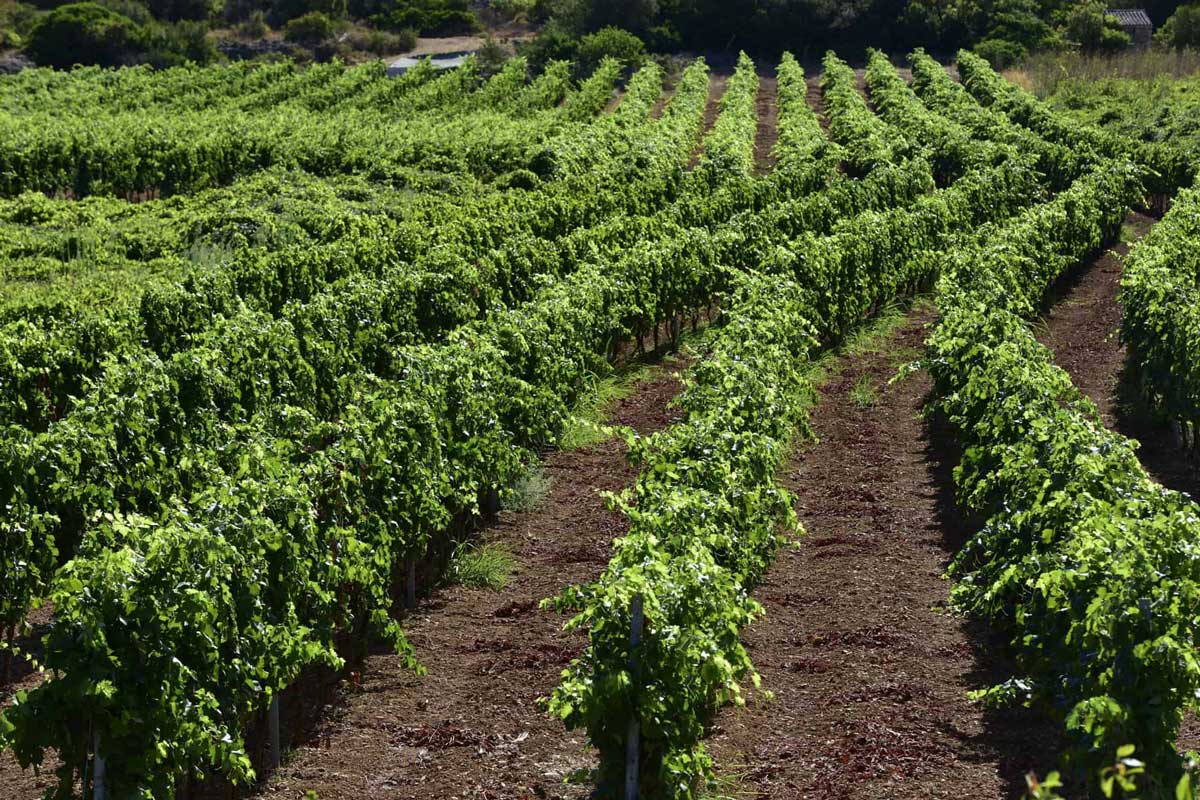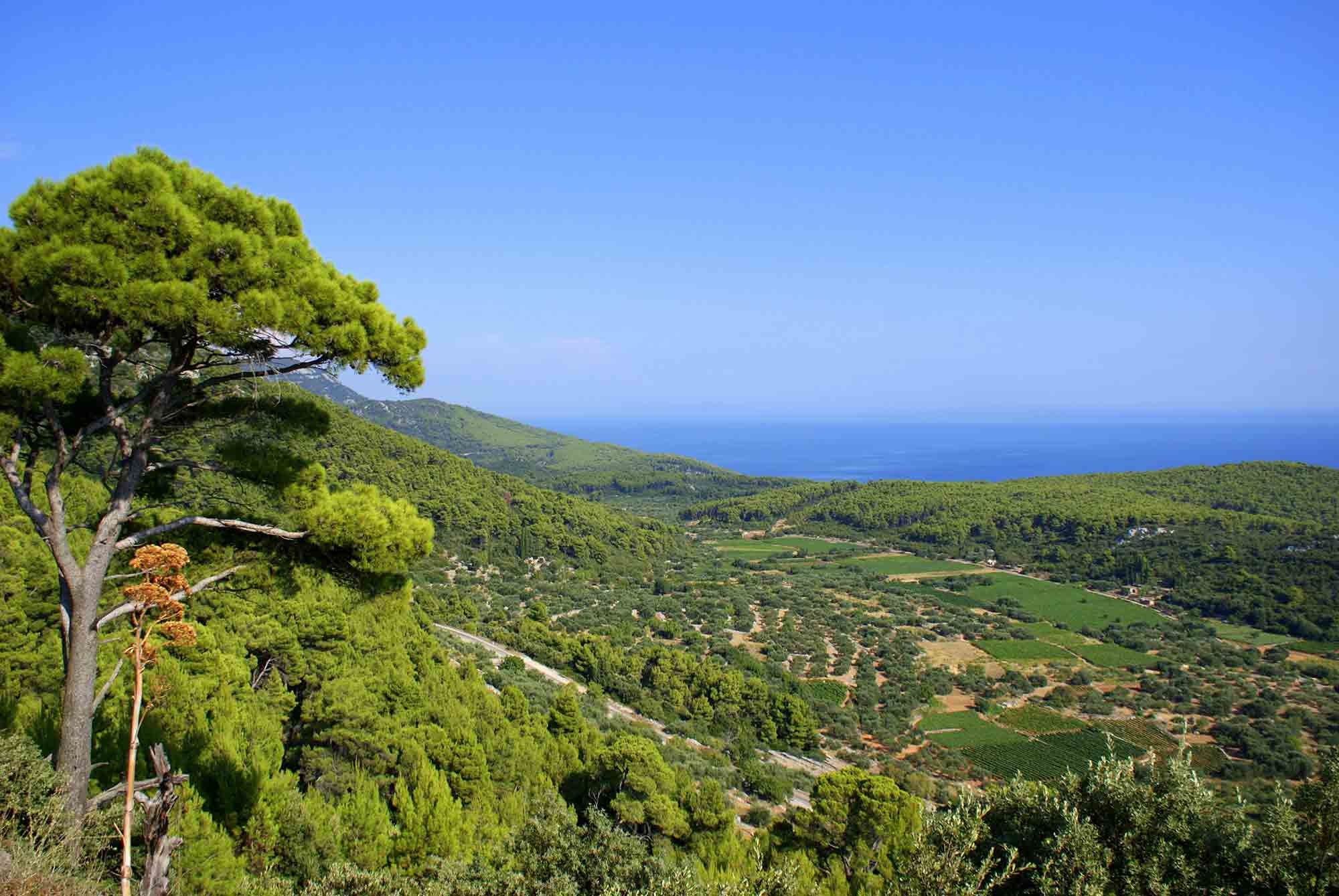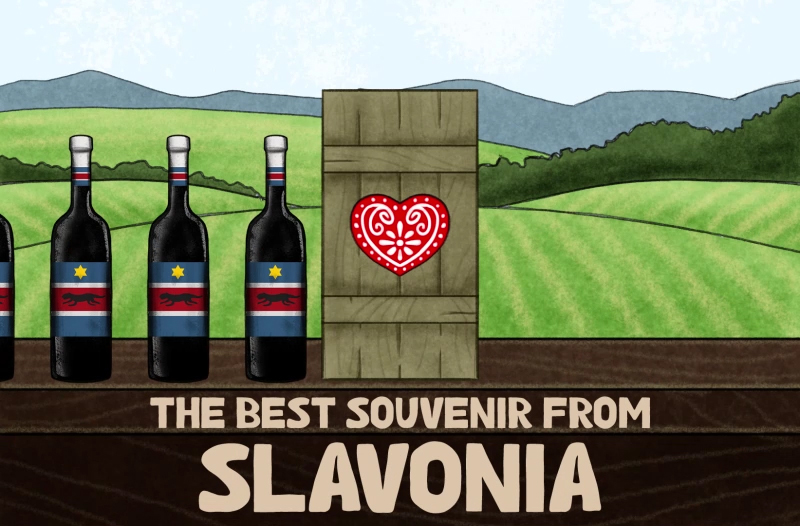Plavac Mali Story: Guide to Croatia’s Indigenous Red Wine
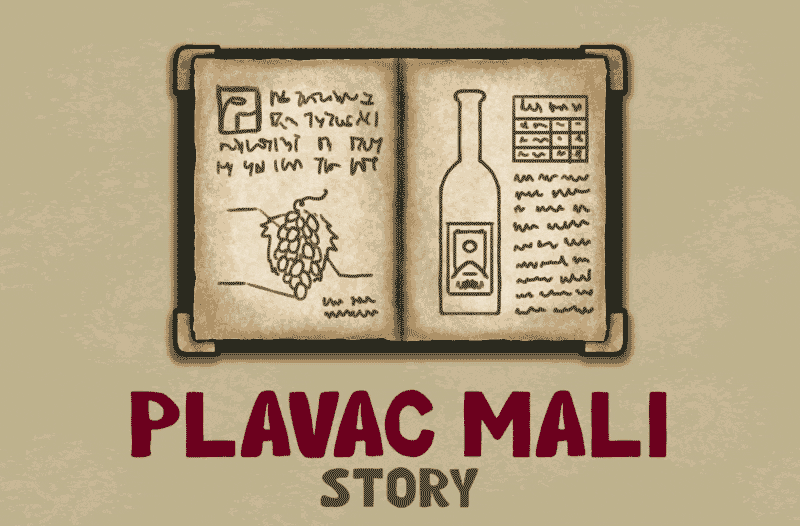
Origins and Plavac Mali story
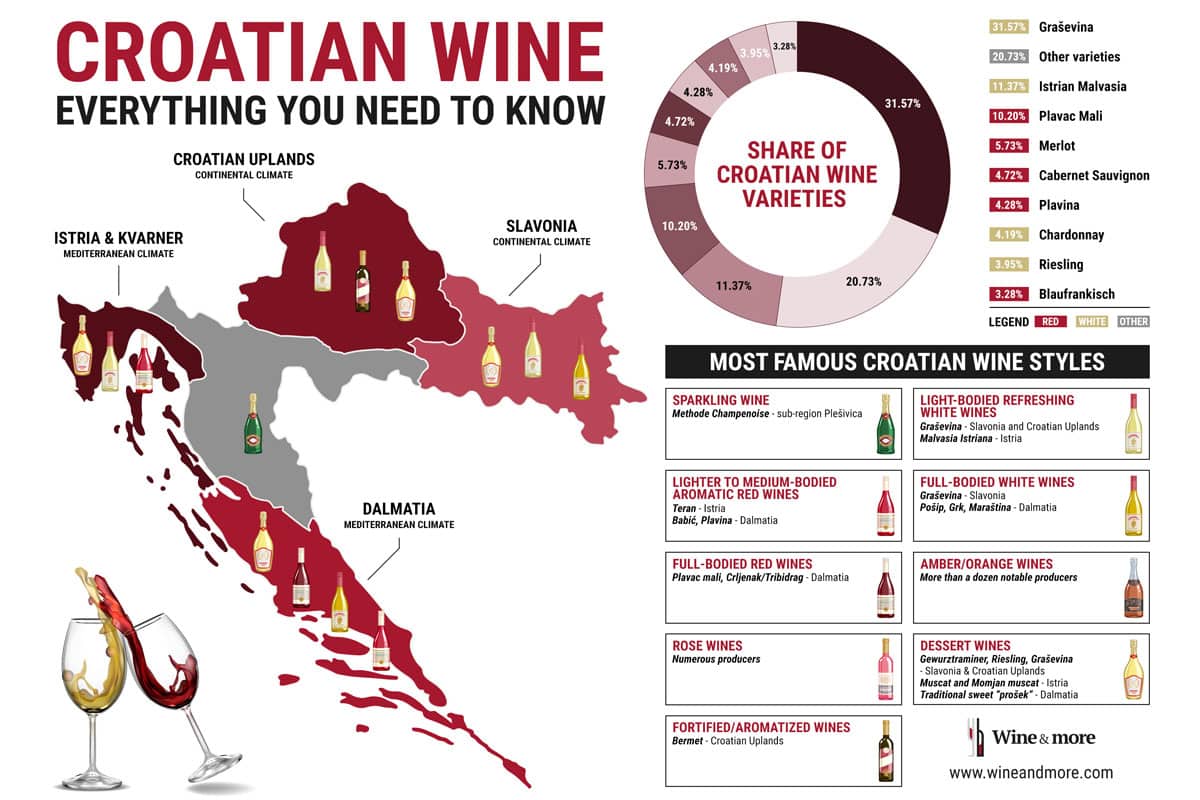
Plavac Mali (pronounced Plah-vatz Mah-lee) is the most planted red variety in Croatia and a favorite among Dalmatian wines. This southern Croatia wine region’s unique terroir produces a wide variety of indigenous red and white wines with distinct flavors and aromas.
If you’ve ever tried Croatian wine, chances are that Plavac Mali was among them! Some of the country’s finest, and priciest, wines are made from the mentioned.
The Latin “Nomen est omen” or “It’s all in the name” rings true for Plavac Mali. ‘Plavac’ means ‘blue’ and ‘mali’ means ‘small’, perfectly describing the grapes’ appearance on the vine.
Plavac Mali’s interesting history and background story have intrigued wine experts for ages. Its true origin was a mystery for years, especially because it was linked to Zinfandel (people often mixed up Plavac Mali with Zin).
If a Californian gave Plavac Mali a try, they’d likely feel right at home. And if it happens to you, don’t be surprised!
Mike Grgich, a renowned California winemaker of Croatian origins, opened Grgich Hills Estate in Napa Valley back in 1958. He was one of the early supporters of the idea that Zin had Croatian origins.
When he saw vines in California, he was convinced that Zinfandel must have originated in Dalmatia and that it was either Plavac Mali or a close relative.
He was so sure about it that he even supported some of the most groundbreaking DNA research to prove his point!
How the grapes found their way from a small Mediterranean region to California has been tickling the brains of wine geneticists and winemakers for decades.
DNA research, spotlighted in the documentary ‘Dossier Zinfandel’, confirmed in 2000 that Plavac Mali “parents” are native varieties of Crljenjak Kaštelanski (the ancestor of Zinfandel) and Dobričić (an ancient red grape from the Šolta Island).
To learn more about this intriguing research, check out our article uncovering the true origins of Zinfandel. Or you can simply watch this video!
What are the characteristics of Plavac Mali?
Plavac Mali is a late-ripening and low-yielding grape variety. It varies in style and its characteristics depend on the winemaking techniques, specific terroir, and micro-locations where the grapes are grown. You can find wines ranging from more approachable and fruit-forward to those with greater complexity and aging potential.
Typically, Plavac gives bold, flavorful wines with higher alcohol and tannins. These wines are mostly dry but can also be semi-dry or sweet, Prošek wines. Prošek is a highly esteemed traditional Croatian dessert wine, made from specially dried clusters of ripened Plavac Mali grapes. It’s a treat for special moments, perfect as an apéritif or after-dinner delight.
Trying Plavac Mali wines from various producers and subregions can help you grasp the range of flavors and styles this grape offers.
Plavac wines from the warmest regions, like the protected geographical appellation of Dingač on the Pelješac Peninsula, are thick, powerful, chewy, and rich in dark berry aromas such as blackberry, blueberry, or plum jam. They can also reveal the aromas of dried figs, carob, raisins, and sweet spices.
Oak-aged Plavac Mali wines tend to have more pronounced aromas of leather, cedar, baked fruit, and sweet spices. These wines are usually
- medium to full-bodied,
- with higher alcohol content,
- powerful yet well-integrated tannins, and
- moderate acidity.
The finest examples will have a juicy, long-lasting finish.
Stina Winery from Brač Island is trying out new methods to make their Plavac Mali wines more vibrant, layered, and complex.
By handpicking top-quality grapes from seriously fascinating and extreme single vineyards such as Stipančić and Murvica, they produce Plavac Mali labels of world-class quality.
Plavac Mali is bold, dense, and tannic—it’s not for the faint of heart. However, when crafted skillfully, Plavac can reach heights of greatness that surpass any other Croatian variety.
Here are some of the key characteristics associated with the Plavac Mali grape variety:
- Color: Plavac Mali wines typically have a deep red to garnet color. In the glass, most Plavac Mali wines are not transparent.
- Aroma: The wines often offer a complex aromatic profile. They evolve as you sip, revealing layers of dark fruits like blackberries and plums, and occasionally carobs, dried figs or cherries. You might also catch whiffs of Mediterranean herbs like sage or thyme, along with spicy and peppery notes.
- Body: High-quality Plavac Mali wines tend to be rich, full-bodied, bold and intense. They offer a substantial feel on the palate.
- Tannins: Tannins are an essential part of varietal character. The tannins in Plavac Mali provide structure and can be pretty firm. This characteristic can help the wines age well, and become smoother and more balanced over time. Aging in wooden barrels is a common practice to soften Plavac Mali tannins, although there are also excellent examples of Plavac Mali wines aged in stainless steel tanks.
- Alcohol Content: Thriving in the rocky soils of Dalmatia, Plavac Mali grapes tend to naturally accumulate lots of sugars. Plavac Mali wines typically have a moderate (13.5%) to high alcohol content (16%), adding richness and warmth in the finish. Balancing alcohol levels is one of the biggest challenges in making Plavac Mali wines.
- Terroir Influence: The distinct qualities of Plavac Mali wines can differ significantly based on the specific location where the grapes grow. Wines from various subregions and microclimates may showcase their special characteristics. Dingač and Postup on the Pelješac peninsula are renowned for producing exceptional Plavac Mali wines. Another noteworthy appellation is Komarna, situated across the Pelješac Peninsula. Additionally, some of the finest Plavac Mali micro-locations can be found on the islands of Hvar, Brač, and Vis.
- Lower Acidity: This is a characteristic of Plavac Mali grapes. When acidity is lower, it can make the fruit flavors in the wine stand out more, making it seem sweeter, even if it’s actually dry.
- Ageing Potential: Plavac Mali wines have shown they can mature and become more complex over time. The best ones really shine after aging for 20+ years or even longer.
- Terroir Wines: Plavac Mali is known among winemakers for its tendency to ripen unevenly, except when it’s grown in specific terroirs that yield exceptional wines. It’s not unusual to find both unripe green berries and ripe raisins on the same grape cluster.
Plavac Mali flavors
Typical Plavac Mali flavors and aromas include:
- carob,
- sage, thyme,
- dried figs, dried cherries, raisins,
- dark cherries, blueberries and plums,
- pepper, and spices, leathery aromas,
- stony minerality.
What is Plavac Mali similar to?
Plavac Mali is part of a group of Mediterranean red varieties influenced by the distinct terroir of the Dalmatian coast and the Adriatic Sea. Here are some of the most common similarities presented in a table format:
| Comparison Criteria | Plavac Mali | Zinfandel | Touriga Nacional | Agiorgitiko |
|---|---|---|---|---|
| Flavor Profile | Unique characteristics, dark fruit notes, dried | More fruit-forward, higher acidity | Concentrated dark fruit aromas, firm tannins | Rich, dark fruit flavors, low acidity, high alcohol |
| Tannin Structure | Typically robust and structured | Generally softer and easier to shape | Firm tannins | Firm tannins |
| Terroir Influence | Influenced by Dalmatian coast terroir | Varies depending on region and terroir | Influenced by Portuguese terroir | Influenced by Greek terroir |
| Structural Similarities | Shares some structural and aromatic traits | Shares some flavor profiles but differs in structure | Shares structural and aromatic similarities | Shares some structural and aromatic traits |
| Regional Origin | Dalmatian coast, Croatia | Various regions around the world | Portugal, Douro, Alentejo, Dāo | Greece, Nemea, Attica, Macedonia |
This table summarizes the comparison between Plavac Mali, Zinfandel, Touriga Nacional, and Agiorgitiko based on various criteria such as flavor profile, tannin structure, terroir influence, structural similarities, and regional origin.
Plavac Mali shares similarities with the Portuguese grape Touriga Nacional and the Greek native grape Agiorgitiko.
Touriga Nacional, known for its deep color, concentrated dark fruit aromas, and firm tannins, shares structural and aromatic similarities with Plavac Mali.
Similarly, Agiorgitiko’s small berries and thick skins contribute to its high phenolic levels. It also tends to have low acidity and high alcohol content, along with rich, dark fruit flavors, making it a closer match to Plavac Mali than Zinfandel.
Terroir influence on Plavac Mali wines
Plavac Mali shows us firsthand how the specific conditions of terroir and microclimate impact both the grape and the resulting wines.
Thriving in the hot Mediterranean climate, rocky and poor soil, Plavac Mali grapes flourish, particularly on the sun-soaked southern slopes, yielding full-bodied wines known for their outstanding quality and ability to age.
Plavac Mali can pose a challenge for winegrowers if it’s not grown in optimal conditions. Its tendency to ripen unevenly is well recognized.
When fully ripe, it often has high levels of tannins and sugars, but lower acidity. This can make it difficult for winemakers to achieve balance in Plavac Mali wines.
Exceptional terroir showcases Plavac Mali’s renowned characteristics.
Traditionally, the best vineyard positions for Plavac Mali were considered to be the southern, steep slopes of Dalmatian islands and land. Such are the southern positions on Pelješac Peninsula (famous Dingač, Postup, Ponikve, Trstenik, Mili), southern slopes on the island of Hvar (Ivan Dolac, Sveta Nedjelja), southern slopes of Brač island (Murvica, Stipančić).
However, subregions like Komarna, the islands of Vis and Korčula, and the northern Dalmatian site of Jadrtovac are also gaining attention for offering perfect conditions for Plavac Mali, particularly for achieving a balanced flavor profile.
Triple insolation Plavac Mali
When discussing Plavac, one term frequently mentioned is “triple insulation.” Sloped vineyards provide triple insolation:
- maximum exposure to direct sunlight and sea breezes intensified due to limited rainfall,
- sea-reflected sun rays from a nearby coastline and vineyards on 45° inclined slopes,
- plus additional light reflection from skeletal white rock surfaces beneath the vines.
In short, triple isolation, refers to the maximum sun exposure reaching Plavac grapes on the vine from three directions on the extremely steep southern slopes: directly, reflected from the white stone in the soil, and reflected from the sea.
With an increase in dry periods and climate change, this distinctive feature becomes more of a drawback than a benefit. Some Plavac Mali wines suffer from a lack of balance because of uneven or overripe grapes and low acidity, resulting in a somewhat dull taste.
However, the famous positions mentioned above have their differences. For instance, Plavac from the Komarna subregion is seldom overripe, yet it tends to be highly concentrated and tannic, but balanced.
The same holds true for Plavac Mali Stipančić from a single vineyard of the same name on the Brač island.
Plavac Mali from Vis Island stands out for its ability to stay balanced even with higher alcohol levels. The sandy sediment in the topsoil and throughout the soil composition helps the Plavac Mali vines achieve optimal ripeness.
So, if you come across a bottle of Plavac Mali with 15% alcohol or more, don’t immediately assume it will taste too alcoholic. In fact, in the finest examples, you may not even notice the high alcohol content.
Where do the best Plavac Mali wines come from?
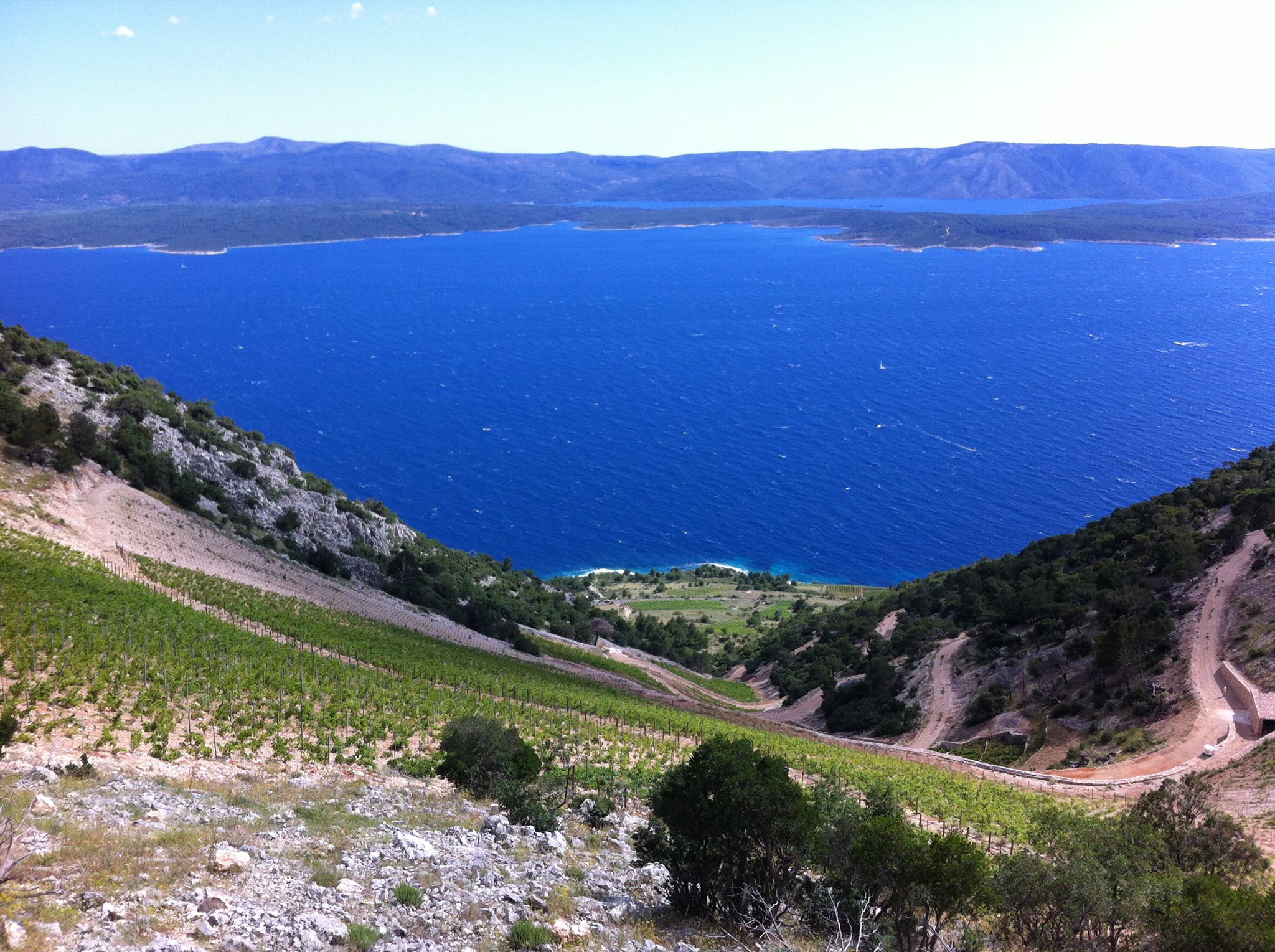
The top Plavac Mali appellations have a classic Mediterranean climate: hot, dry summers and plenty of sunshine and sea breeze that create a disease-free environment. The limestone-rich, porous soil quickly absorbs the rain, storing water in deeper layers accessible by the vines’ deep roots, which can extend up to 10 meters. This creates the perfect conditions for Plavac Mali grapes to thrive.
The most famous wine appellations known for outstanding Plavac Mali wines are:
- Dingač and Postup on the Pelješac peninsula,
- Hvar Island, especially Ivan Dolac and Sveta Nedilja,
- Brač Island, especially Murvica and Stipančić,
- Vis Island,
- Komarna,
- and other distinctive subregions in Korčula Island, or
- Jadrtovac near Šibenik.
Plavac Mali from Pelješac Peninsula
The Pelješac Peninsula is famous for being the heart of Croatia’s best red wines, earning it the title of the “wine kingdom” of Plavac Mali.
While white grapes are also grown on the peninsula, it’s the native Plavac Mali that truly puts this region on the world wine map.
In Croatia, when one talks about red wines and Pelješac, the first word that passes one’s lips is – Dingač.
Plavac Mali grape thrives in extreme conditions of this beautiful, rugged, and utterly wild seven-kilometer stretch of coastal land. It’s without a doubt one of the most unique Croatian appellations.
Exploring it is essential, not just for wine enthusiasts, but for anyone eager to uncover one of the most captivating vineyards globally.
Dingač was the first wine appellation in the former state to receive geographical protection, back in 1962.
Only wines made from grapes harvested from old bush-trained vines in this specific appellation can be labeled as Dingač.
Winemakers hold onto this distinction proudly because Dingač wines are renowned worldwide, thanks to the many favorable conditions that contribute to their quality.
Postup is another renowned area for cultivating Plavac grapes on the peninsula. It was actually the second Croatian wine appellation, after Dingač, to be granted state protection (now known as Protected Geographical Status) back in 1967.
Other renowned subregions in Pelješac are Ponikve, Trstenik, and Mili.
Family-owned wineries are gaining increasing recognition in the global market for producing exceptional and highly regarded signature wines, with consumers showing a preference for labels from these smaller producers.
The wine kingdom of Pelješac is also attracting foreign investors, who now own some of the most esteemed wineries in the area.
If planning a Croatian vacation, Pelješac offers a diverse range of wineries. From smaller producers crafting cult Croatian wines to high-end modern must-visit Dalmatian wineries offering luxurious accommodations, wine, and fine dining experiences, Pelješac has it all!
Plavac Mali from Brač Island
Brač Island isn’t just famous for its breathtaking scenery, one of the best beaches in Croatia, and historic landmarks, but also for its vineyards and rich winemaking heritage.
The island’s climate, soil, and local grape varieties all play a part in making top-quality wines, appreciated both at home and abroad.
In Bol, there’s an impressive winery known as Stina Winery, renowned for its Plavac Mali wines.
It’s fair to say that the vineyards from which they source grapes are among Croatia’s most extreme and stunning. They’ve put a lot of effort into restoring these vineyards to their former glory.
Stipančići and Murvica vineyards are located on incredibly steep slopes, making them some of the most extreme vineyards in Croatia. Among them, Murvica stands out as the highest-altitude vineyard on the island.
Everything about it is exceptional, from its steepness to its panoramic view. With a staggering 70% inclination, harvesters need to fasten crates to themselves to avoid slipping down into the depths.
For visitors, the experience is breathtaking, and it feels like your heart drops to your feet. But for those who work here every day, it’s just another day at the office.
Given the extreme slopes, climate conditions and unique cultivation methods, the conditions are perfect for Plavac to flourish.
Three successful and internationally known Plavac Mali labels from Stina Winery will give you a remarkable insight of Brač terroir:
Stina Plavac Mali Majstor is made from grapes harvested from the best positions for Plavac Mali, on the southern slopes of the island of Brač around the village of Murvica (west of Bol). The grapes receive ample sunlight during ripening.
Plavac Mali Majstor, with its abundance of red and black fruits, generous yet refined tannins, and lavish and well-integrated influence of wood obtained during aging, represents the excellent potential and value of this variety. This wine is rich in extract with long aging potential. It’s a wine for true connoisseurs. We recommend serving it at 18°C or 64°F with grilled meat or aged cheese.
Stina Plavac Mali Stipančić is a single-vineyard, quite atypical wine for the Plavac Mali. It is extremely concentrated and extractive but has retained a lot of freshness.
Its bouquet is so rich that we can talk about a famous, massive wall of aromas characteristic compared to world’s greatest red wines.
Pustinja Stipančić is one of the finest vineyard sites on the Dalmatian islands. It’s an extremely steep vineyard with a southern exposure, partial double insolation, and a base of rocks, red soil, and clay. Located near the famous Murvica, the name “Pustinja” comes from the desert monastery from the 15th century.
On the nose, you can sense basic aromas of plums and Mediterranean scrub, with some smoke, humidor, and leather. The taste is dense, with lots of fruit and a bit of dark chocolate; it has a long and mineral finish. It should be paired with elaborately prepared red meat dishes, with mushrooms, with truffles, especially white ones, and with the finest dark chocolates.
Stina Plavac Mali Remek djelo is quite a perfect name for this wine. It’s a dry, yet rich, fruity, and flavorful wine produced in exceptional years. Only 350 bottles are produced. The tannins are silky on the palate, and the fruitiness is rich. It’s extractive and full-bodied, yet simultaneously elegant with perfectly integrated oak components.
Plavac Mali from Hvar Island
In Hvar, Croatia’s sunniest island, Plavac grapes soak up plenty of sunshine. Vineyards stretch along the coast, basking in the sunlight bouncing off the sea and rocky terrain. Each grape absorbs the full force of the sun’s rays, packing a powerful punch of flavor.
Situated along Croatia’s Dalmatian coast, Hvar Island is famous for its beautiful beaches, lively nightlife, and abundant lavender fields, olive groves, and vineyards.
Despite its size, Hvar Island holds a big place in the history and culture of winemaking. With roots tracing back to the 4th century B.C., viticulture has long been integral to the island’s identity.
The Stari Grad Plain vineyards are a UNESCO heritage site, known for its historical and cultural importance. The agricultural system in the Stari Grad Plain reflects the ancient Greek way of dividing and farming the land.
This area has a maze of plots marked by dry-stone walls, showing how the land was organized for farming. The design of the plain reveals the smart and sustainable methods the Greek settlers used to manage the land. Today, the Stari Grad Plain lets people see how farming was done in ancient times. It’s still actively used for agriculture, keeping its legacy alive.
The dominant grape variety here is Plavac Mali, constituting 70% of all plantings. Hvar Island is known for some of the most unique and extreme vineyards.
These vineyards spread along the coastline, spanning from famous appellations like Ivan Dolac and Milna to Sveta Nedjelja and beyond to Zavala. It’s a stunning area where the Mediterranean sun and sea work together to create outstanding wines.
Plavac Mali from Vis Island
Vis Island stands out among the Dalmatian islands for several reasons. It’s not just its remote location that sets it apart, but also the scarcity of vineyards on its southern slopes overlooking the Adriatic Sea.
Plavac Mali grown on Vis Island has a unique quality: it can handle high alcohol levels while still staying balanced.
There are many reasons for this besides just how the grapes are grown. The type of soil on Vis Island is really important for how the grapes ripen.
The soil in the vineyards of Vis Island is quite sandy compared to other places where they grow top-quality Plavac Mali. This sandy soil probably helps the Plavac Mali vines on Vis Island ripen just right, so the wines they produce stay balanced, even when they have higher alcohol levels.
The majority of Vis Island’s vineyards are located inland, on the limestone fields. Each field provides unique characteristics to the grapes grown there.
Here are four great examples: the Vislander Winery’s four different Vis Island Plavac Mali wines.
Plavac Mali from Korčula Island
Korčula stands out among the Dalmatian islands for its unique characteristics. Covered with dense forests, it’s often referred to as the “black island.” Interestingly, Korčula is renowned for its white wines Pošip and Grk, a departure from the typical Plavac Mali domination in Dalmatian vineyards.
For example, Plavac Mali from Lumbarda is greatly different in style and character. It carried the same recognizable aromatic profile, only in a much thinner body. The tannins are also softer and the weight is supported by lively freshness, often a crucial issue for Plavac Mali.
Plavac Mali from Komarna
Komarna wine subregion is Croatia’s youngest and fully organic wine-growing appellation. Situated across from Pelješac, Komarna enjoys a south-southwest orientation. Vineyards are planted in varying altitudes, from 250 meters to sea level, with an average slope of 30%, reaching up to 45% in certain vineyards.
Thanks to its proximity to the sea and excellent aeration, Komarna is perfect for eco-friendly wine production, needing minimal protective treatments. The microclimate is favorable, offering abundant sunshine hours, and constant sea breeze with the sun’s reflection from the sea and limestone surfaces providing above-average sun exposure.
Unlike Pelješac, nights in Komarna are cool, so Plavac Mali wines from Komarna retain a lot of freshness. When tasting you will find it with less jam and plum characteristics, yet the wines will remain concentrated and powerful like Plavac from renowned Dingač and Postup appellations.
The Komarna region proves that Plavac Mali can express different qualities while remaining equally exceptional, genuine, and downright delicious.
What food goes best with Plavac Mali?
| Food | Description |
|---|---|
| Mature cheeses | Cheeses aged, such as Parmesan and Pecorino, bring a salty and savory touch to Plavac Mali’s bold fruitiness, creating a harmonious balance. |
| Duck confit | Duck confit harmonizes beautifully with the wine’s bold texture. |
| Grilled meats | Plavac Mali’s full-bodied goes wonderfully with grilled meats like lamb chops and steak, bringing out their savory flavors and offering a delicious contrast. |
| Game meats | Plavac Mali’s strong tannins go hand in hand with the rich, earthy tastes of game meats like venison and wild boar. |
| Grilled lamb chops | Plavac Mali pairs perfectly with juicy, grilled lamb chops. The grill’s charred, smoky flavors elevate the wine’s complexity even further. |
| Herb-infused roasted vegetables | Roasted vegetables with aromatic herbs make a tasty mix that perfectly complements the wine’s spicy notes and enhances its aroma. |
| Dark chocolate desserts | The fruity flavor of Plavac Mali balances out the bitterness of dark chocolate, making for a tasty contrast in desserts such as chocolate cake or mousse. |
Plavac Mali and seafood pairing
Though Plavac Mali is commonly enjoyed with hearty meat dishes, it prompts the question: can this bold and intense red wine also complement the seafood?
Young Plavac Mali wines burst with lively cherry flavors, while aged ones offer a complex blend of dark berries like blackberry and blueberry, along with hints of plum jam, smoke, tobacco, and dried herbs and spices. These flavors complement grilled or smoked fish perfectly.
Fatty fish and Plavac Mali go hand in hand, as the richness of the fish’s fat and the structure of the wine’s tannins complement each other well. The fish’s fat contains flavors that the tannins enhance, while also mellowing out their sharpness.
Whether you’re grilling, broiling, or pan-frying, these methods work well for cooking fatty fish. And Plavac Mali is a great match for any cooking style.
What does Plavac Mali not pair well with?
While it pairs well with many dishes, certain foods don’t quite match Plavac Mali’s characteristics.
Tips for food and Plavac Mali pairing
Conclusion
If you want to explore new wines, trying a Croatian one is a fantastic idea. Plavac Mali is perfect if you’re new to Croatian wines.
If you’re not sure where to begin, our Plavac Mali wine selection is a great start. It’ll help you understand its aroma and flavors better.
We guarantee that trying this Croatian red will make you see Croatian wines in a whole new light!



